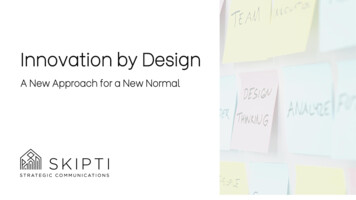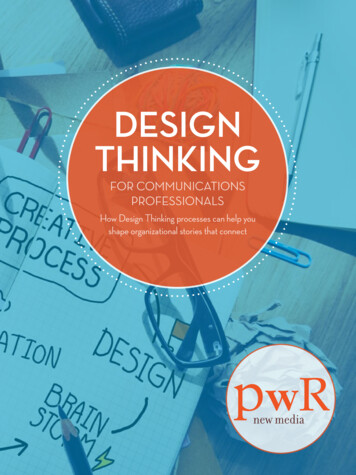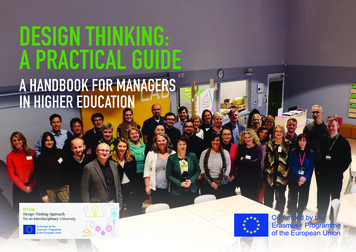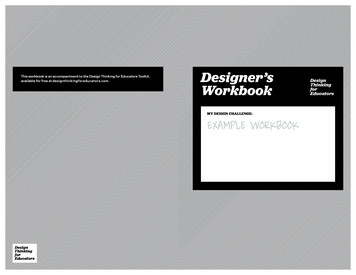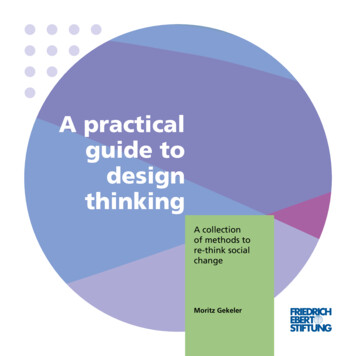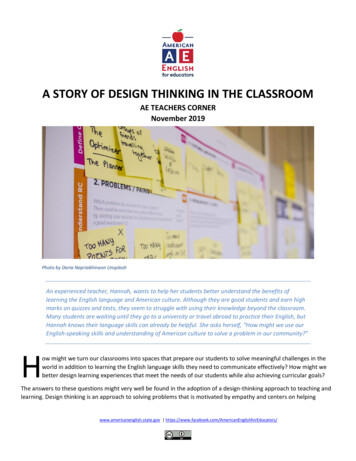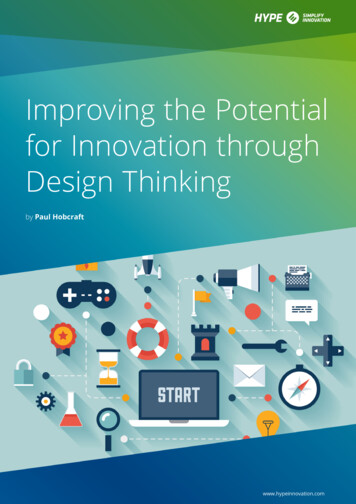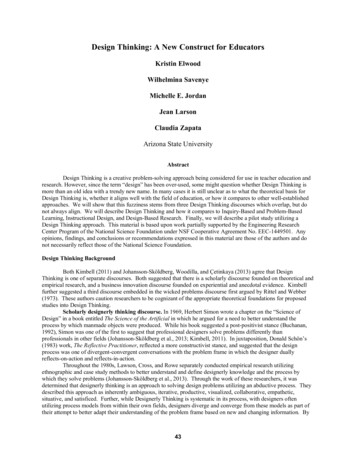
Transcription
Design Thinking: A New Construct for EducatorsKristin ElwoodWilhelmina SavenyeMichelle E. JordanJean LarsonClaudia ZapataArizona State UniversityAbstractDesign Thinking is a creative problem-solving approach being considered for use in teacher education andresearch. However, since the term “design” has been over-used, some might question whether Design Thinking ismore than an old idea with a trendy new name. In many cases it is still unclear as to what the theoretical basis forDesign Thinking is, whether it aligns well with the field of education, or how it compares to other well-establishedapproaches. We will show that this fuzziness stems from three Design Thinking discourses which overlap, but donot always align. We will describe Design Thinking and how it compares to Inquiry-Based and Problem-BasedLearning, Instructional Design, and Design-Based Research. Finally, we will describe a pilot study utilizing aDesign Thinking approach. This material is based upon work partially supported by the Engineering ResearchCenter Program of the National Science Foundation under NSF Cooperative Agreement No. EEC-1449501. Anyopinions, findings, and conclusions or recommendations expressed in this material are those of the authors and donot necessarily reflect those of the National Science Foundation.Design Thinking BackgroundBoth Kimbell (2011) and Johansson-Sköldberg, Woodilla, and Çetinkaya (2013) agree that DesignThinking is one of separate discourses. Both suggested that there is a scholarly discourse founded on theoretical andempirical research, and a business innovation discourse founded on experiential and anecdotal evidence. Kimbellfurther suggested a third discourse embedded in the wicked problems discourse first argued by Rittel and Webber(1973). These authors caution researchers to be cognizant of the appropriate theoretical foundations for proposedstudies into Design Thinking.Scholarly designerly thinking discourse. In 1969, Herbert Simon wrote a chapter on the “Science ofDesign” in a book entitled The Science of the Artificial in which he argued for a need to better understand theprocess by which manmade objects were produced. While his book suggested a post-positivist stance (Buchanan,1992), Simon was one of the first to suggest that professional designers solve problems differently thanprofessionals in other fields (Johansson-Sköldberg et al., 2013; Kimbell, 2011). In juxtaposition, Donald Schön’s(1983) work, The Reflective Practitioner, reflected a more constructivist stance, and suggested that the designprocess was one of divergent-convergent conversations with the problem frame in which the designer duallyreflects-on-action and reflects-in-action.Throughout the 1980s, Lawson, Cross, and Rowe separately conducted empirical research utilizingethnographic and case study methods to better understand and define designerly knowledge and the process bywhich they solve problems (Johansson-Sköldberg et al., 2013). Through the work of these researchers, it wasdetermined that designerly thinking is an approach to solving design problems utilizing an abductive process. Theydescribed this approach as inherently ambiguous, iterative, productive, visualized, collaborative, empathetic,situative, and satisficed. Further, while Designerly Thinking is systematic in its process, with designers oftenutilizing process models from within their own fields, designers diverge and converge from these models as part oftheir attempt to better adapt their understanding of the problem frame based on new and changing information. By43
the 21st century, continued research in the field led Cross (2011) to the suggestion that designerly ways of knowingcould be utilized within any field as a more general Design Thinking approach.Wicked problems design thinking discourse. Johansson-Sköldberg et al. (2013) considered the wickedproblems Design Thinking discourse to be a refinement of the Scholarly Designerly Thinking discourse since it stillrelies on the same theoretical foundations. However, Kimbell (2011) argued that the addition of Rittel andWebber’s (1973) Wicked Problems approach changed aspects of the original conversation, which warranted its owndiscourse. This offshoot occurred when Buchanan (1992) suggested that the Design Thinking discourse wasbecoming too scientific. He suggested that while researchers should scientifically study the design process, thedesign process itself should not be likened to a scientific process as originally suggested by Simon (1969).Rittel and Webber (1973) argued that solutions for “wicked” problems must be determined within contextbecause a systematic formula for solving them does not exist. Because the designer satisfices the solution bydetermining the stopping point for the solution when it is good enough, wicked problems are technically withoutfinal solutions. While wicked problems may seem similar to other known problems, there will always be someaspect that is unique. Therefore, designers must be careful about selecting an obvious solution too early in theprocess. Also, one determined wicked problem may simply be the symptom of a greater wicked problem.Buchanan (1992) utilized learning theory from John Dewey (1986) combined with these wicked problemcharacteristics to describe a Design Thinking process as a balance between the analytic and creative.Innovative design thinking discourse. The Innovative Design Thinking discourse seems to haveoriginated in the early 1990s when Stanford University mechanical engineering professor David M. Kelleyparticipated in a merger of several design firms which led to the creation of the design consulting firm IDEO(Johansson-Sköldberg et al., 2013; Kimbell, 2011). Kelley continued to work for Stanford and be part of IDEO.While at Stanford, he taught design education courses utilizing design process strategies. In 2005, he partnered withthe Hasso Plattner Institute in Potsdam, Germany, to create the Stanford University Hasso Plattner Design School,nicknamed the d.School (d.School, 2016). As part of this program, students from any degree field may take courseson problem solving utilizing the Stanford model within a design studio environment. Concurrently, Roger Martin(2009), Dean of the Rotman School of Management for the University of Toronto and former consultant for IDEO,and Tim Brown (2009) current CEO and president of IDEO, made an argument that the Design Thinking approachcan be applied within almost any field to develop innovative solutions. Most recently IDEO, in conjunction with aschool district, created a Design Thinking for Educators toolkit based on the IDEO Design Thinking process model(IDEO, 2016).Much of the literature from this discourse supporting the IDEO and Stanford models was based on thepersonal experiences or anecdotal evidence of these designers. This does not suggest that their models lack impactor efficacy; it simply means they were not empirically-based. Yet the Stanford and IDEO models are quicklybecoming the basis for empirical studies beyond the field of business, such as healthcare and education. This maybe due to the strongly parsimonious nature of their models. However, the Scholarly Designerly Thinkingresearchers would argue that Design Thinking cannot be diluted down to a linear process model as this would defeatits base assumptions (Cross, 2001, 2011; Lawson, 2006; Rowe, 1991). With this in mind, it is a combination of theScholarly Designerly Thinking and Wicked Problems Design Thinking discourses, both of which are theoreticallyand empirically-based, that will form the basis for this discussion.Design Thinking ApproachThough Design Thinking researchers agreed that certain assumptions define the Design Thinkingapproach—such as ambiguity, iteration, production, visualization, collaboration, empathy, situation, andsatisficing—the abductive, non-linear nature of the process does not suggest a simple process model (Cross, 2006;Buchanan, 1992; Rittel & Webber, 1973). Design Thinking’s fuzziness of construct might suggest a whimsicalnature in which only those attuned to some magical internal force can use it successfully. Yet, researchdemonstrated that while it involves creativity of thought and a willingness to accept uncertainty, Design Thinking ismost often conducted in an extremely systematic way (Cross, 2001, 2006; Lawson, 2006; Rowe, 1991).Designers may have been taught a traditional linear process model for their specific design field; however,in practice they often did not follow these models step-by-discrete-step. Instead, they purposefully used a recursiveprocess to diverge from one step to return to an earlier one, often picking up new information in the process. Thisproblem-framing process caused the designer to simultaneously understand the initial problem while searching for asolution (Cross, 2006; Lawson, 2006; Schön, 1983). This caused designers to change and reconstruct their frameover and over again. It is likely that they begin by developing many mini solutions—which diverged from thetraditional process to follow certain aspects of those solution paths—and tested them by building or sketching44
models until the rationale they followed collapsed and led them to converge again. Eventually this fluctuatingdivergence-convergence of problem-solution paths narrows and slows, until through a situation of satisficing, thedesigners decide they have a workable solution for that situation in that moment. Please note that this process is notgeared to finding THE BEST possible solution; instead, it searches until it finds a workable one. However, it ispossible that the workable solution is the best possible solution.As part of this process, most designers clarify the problem, seek empathy through multiple stakeholderperspectives, develop ideas through prototypes, and then test those prototypes (Cross, 1990; Kimbell, 2011). Theyalso reflect and revise throughout (Schön, 1983). However, note that Design Thinking researchers have refrainedfrom developing their own Design Thinking process model perhaps fearing that such a model would implysequential, discrete stages to be followed in a rigid way, which would defeat its very assumptions (Buchanan, 1992).At the same time, Cross (2006) strongly conveyed the importance of sketching and visualization as a method forincreased insight when working with wicked problems. With that in mind, Figure 1 demonstrates the asymmetricalfluctuating nature of the process. Problem Frame Wicked Problem Figure 1. Visualization of the Design Thinking Approach.Design Thinking ComparisonDesign Thinking encompasses the base assumptions and processes utilized by professional designers acrossdesign fields. However, each field has developed its own process models, patterns, and assumptions specific to theirindividual fields. Some design fields, such as graphic, interior, or fashion design more heavily relate to a creativecraft in which intuition plays a larger role. Other more technical fields are built on a stronger foundation ofsystematic analysis, such as engineering, architecture, or instructional design. This does not mean that creativedesign fields are not systematic or are without rules, nor does it mean that analytical design fields ignore context,innovation, or aesthetics. Therefore, while Instructional Design has its own models and processes, it has DesignThinking as a core set of principles and practices in common with other design fields such as graphic design orarchitecture. Also, researchers have begun to build upon the notion of teachers as designers, and to suggest thatteachers need to develop design dispositions (Kali, McKenney, & Sagy, 2015; Koh, Chai, Hong, & Tsai, 2015;McKenney, Kali, Markauskaite, & Voogt, 2015; Svihla, Reeve, Sagy, & Kali, 2015) that will help them adapt to thecomplexity of teaching in the 21st century (Darling-Hammond, 2006; Jordan, 2016). However, there are alreadyseveral well-known problem-solving approaches utilized in teaching.45
Problem-Solving ApproachesHow is Design Thinking different from Inquiry-Based Learning, Problem-Based Learning, InstructionalDesign, or Design-Based Research? To answer this question, we chose to compare their base epistemologies,agents, definitions, roles of the teacher, and assumptions (see Table 1).Agents. For the purpose of this presentation, we define the agent as the person primarily in charge ofmoving the learning approach forward. Without this person, the approach would fall apart. Inquiry-Based Learningand Problem-Based Learning have the learner as the main agent. The designer is the main agent for InstructionalDesign and Design Thinking, and the researcher is the agent for Design-Based Research. While it is possible thatteachers could choose to utilize Design Thinking as a K-12 learning strategy, it is meant to be used with highly illstructured wicked problems and assumes a certain level of base knowledge. Design Thinking would be better usedby teachers as designers to create learning experiences for students. In contrast, Inquiry-Based and Problem-BasedLearning are instructional strategies through which learners come to their own understanding of the content withguidance from the teacher through scaffolding, modeling, and coaching. Instructional Design is most often enactedby a professional who has a degree in an Instructional Systems Design field. While teachers may be taught someInstructional Design methods, they do not have the same level of expertise that the professional designer does andmay find the detailed lesson plans expected within the field to be impractical for their own use in the classroom. InDesign-Based Research an outside researcher works with a classroom teacher to develop, test, and revise a learningintervention.Epistemologies. Two major aspects of educational reform have changed how lesson planning is perceived.First, the No Child Left Behind Act moved schools towards a more standards-based focus, which resulted in highstakes testing and data-driven curricula (Dee & Jacob, 2011). Second, educational reforms, such as Common Core,21st Century Skills, and Next Generation Science Standards have resulted in a drive towards critical thinking andinquiry as equally important as specific content areas (Core Standards, 2016; NASBE, 2016; P21, 2016). Thesehave given rise to constructivism and the learning sciences field (Driscoll, 2007; Jonassen, Cernusca, & Ionas, 2007;Reiser, 2007).All five problem-solving approaches utilize some aspect of a constructivist perspective; however, theydiffer in the degree to which the environment provides learning structure and accountability on the part of the agentfor developing successful solutions. Both Inquiry-Based Learning and Instructional Design continue to lean towardsa post-positivistic science stance, even though they have constructivist leanings. Some Instructional Designers mayargue that constructivism is antithetical to behaviorist and information processing cognitivist-based InstructionalDesign (Reiser, 2007), but Instructional Design has experienced a shift making it more about what works best forthose learners at that time, which is a pragmatism that can work with aspects of constructivism (Smith & Ragan,1999). Proponents of Inquiry-Based Learning describe it as emerging from a constructivist stance in which studentsexplore scientific problems; however, they also heavily rely on a linear 5E stage model and conduct research on howbest to train teachers to its correct use in the classroom (Lakin & Wallace, 2015). This suggests that Inquiry-BasedLearning promotes higher level critical thinking and engages and motivates students through a personal connectionwith the problems, while still heavily promoting right and wrong answers, which is a more post-positivistic stance.Problem-Based Learning, Design Thinking, and Design-Based Research heavily focus on context andexperiential participation; yet, they still assume a systematic process. This suggests that they are moderatelyconstructivist with pragmatist leanings. Some have argued that Problem-Based Learning is too open and lacking instructure to be an effective learning approach (Kirschner, Sweller, & Clark, 2006); however, proponents of ProblemBased Learning argue that, as an approach, it involves heavy scaffolding and has been shown to be empiricallyeffective (Hmelo-Silver, Duncan, & Chinn, 2007). Design Thinking utilizes an abductive fluctuating approach toproblem framing and solving, often combined with the use of a field specific process model. This approach is bothcreative and analytical, and designers are expected to determine when they have reached the most workable solution.Not the correct solution, but the best one at that time given the information they have and the needs of the users.This implies a pragmatism. Design-Based Research is a research method promoted by learning scientists whobelieve “learning, cognition, knowing, and context are irreducibly co-constituted and cannot be treated as isolatedentities or processes” (Barab & Squire, 2004, p. 1). They are constructivists in that the research must be situated incontext; however, they would accept both quantitative and qualitative data as meaningful evidence. This alsosuggests a pragmatist stance, making it pair well with Design Thinking.Definitions. Part of the reason that it is necessary to compare these approaches is the similarity of theirdefinitions. All five approaches define themselves as a way to construct learning as part of participating in problemsolving. Even Design-Based Research develops, implements, and tests learning interventions. However, it issupposed that most research, including Design-Based Research, has at its base an educational learning question and,46
therefore, a problem. Also, the nature of Design-Based Research questions focus on how and why, rather than onwhat, which suggests that these problems are somewhat ill-defined. But problem-solving is not an explicitassumption of Design-Based Research. The other four approaches describe the type of problem best utilized withtheir approach.For example, Inquiry-Based Learning is often paired with science, technology, engineering, and math(STEM) subjects, with a heavy leaning toward science. This approach often uses the 5E model of engage, explore,explain, elaborate, and evaluate (Lakin & Wallace, 2015). Because of the linear aspect of the model, and anassumption that solutions must be supported and rationalized through evidence, this approach works best withstructured problems.Instructional Designers are taught to conduct needs assessments to determine whether or not instruction iseven warranted. However, because of the extremely systematic process they are expected to follow—and the factthat most Instructional Design is created for industry which often provides relatively structured parameters—thisapproach works best with somewhat to moderately ill-structured problems.47
Both Problem-Based Learning and Design Thinking work best with problems that have a highly illstructured nature. However, Jonassen and Hung (2008) suggest that design problems may simply be too abstractand complex for a learner to work through with any level of autonomy. While Problem-Based Learning problemsare extremely ill-structured, Design Thinking problems are wickedly so. Therefore, Design Thinking is best usedwith students who have some content expertise already.48
Roles of the Teacher. The role of the teacher in each of these approaches is quite distinct. In both of thestrategy approaches, Inquiry-Based and Problem-Based Learning, the teacher acts as a guide or facilitator. InInquiry-Based Learning, aspects of the learning can be labeled correct or incorrect. This suggests that the teacherneeds to closely monitor learner understanding and application. In Problem-Based Learning, the learning is morelearner directed. This requires teachers to ensure that learners have opportunities to gain the knowledge they willneed to create an effective solution. With Instructional Design, the teacher acts as the subject matter expert (SME),offering information on the constraints, learning goals, objectives, and issues of style. With Design-Based Research,the teacher is a little bit closer to the research than with Instructional Design. Without the teacher, the researcherwould be shut out of the classroom, so they are co-creating. However, the researcher usually has slightly higherauthority on how the research will be planned and conducted. Lastly, with Design Thinking, the teacher is thedesigner. He/she has the expertise, the knowledge of the classroom, the knowledge of the subject, and is responsiblefor constructing the learning environment. He/she is also aware of any possible constraints. To be the mosteffective though, the Design Thinker will heavily utilize interviews, surveys, and observations of all stakeholders inorder to make the most informed decision they can. This means teachers do not simply assume an understanding oftheir learners, they actually work with them for better empathy and insight.Assumptions. Since all five approaches utilize a constructivist stance on some level, many of theirassumptions overlap. For example, all five approaches suggest some aspect of communication. Inquiry-BasedLearning promotes question asking, Problem-Based Learning requires multiple perspectives, Instructional Designrequires a task analysis which involves working with various stakeholders, Design Thinking is empathetic, andDesign-Based Researchers work with the teacher. Closely connected to this is the concept of collaboration.Problem-Based Learning and Design Thinking explicitly assume collaboration while it is simply implied in the otherthree. All five must develop, implement, and test something, whether that be a hypothesis, curriculum, orintervention. All five also suggest some type of revision, reflection, or evaluation. Yet there are still a few points ofdifference. Problem-Based Learning is more self-directed than Inquiry-Based Learning. Problem-Based Learning,Design Thinking, and Design-Based Research stress the importance of authentic, situated learning problems.Design Thinking sees the power of ambiguity and failure as a learning path, and as such, is extremely iterative whilealso suggesting that the designer satisfices the solution at some point. Lastly, Design Thinking assumes that the bestdesigns are ones that have been visualized through story-boards, concept maps, sketching, and proto-typing or, ineducation, mini-teaches. This does not imply that the other approaches are against visualization or iteration—thesemay even be implied—but they are not a focus the way they are in Design Thinking.Design Thinking Pilot StudyThe 21st-century learning environment has changed what teachers must know and be able to do. Today’steachers face complex and ambiguous issues that can best be defined as wicked problems that require a shift inthinking (Jordan, Kleinsasser, & Roe, 2014). As a way to tackle the uncertainties inherent in education, otherscholars assert that 21st-century teachers need to become designers who consider not just the lesson itself, but alsoaspects of the setting, stakeholders, and resources (Darling-Hammond, 2006; Kirschner, 2015; Lambert & Gong,2010; Svihla et al., 2015) to create a specialized learning experience every time they teach (Laurillard, 2012).Researchers argue that teacher education programs must begin to incorporate Design Thinking, a creative problemsolving process, into their coursework (Kali et al., 2015). As a first step, however, we must first determine howDesign Thinking practices influence education. A Design Thinking educational approach could increaseexperienced teachers’ dispositions towards design by providing a framework for developing higher-level inquiry andinnovation for their students’ learning experiences (Koh et al., 2015) while continuing to align that instruction withcurrent best practices in teaching. However, educational research on Design Thinking is still in its infancy. We aretherefore interested in exploring the following questions:1. How do Design Thinking practices influence STEM teachers’ lesson designs?2. In what ways do STEM teachers believe Design Thinking aligns with the design of learningexperiences?3. How and to what extent do STEM teachers believe Design Thinking practices could be effective inpre-service teacher preparation?MethodWe utilized a Design-Based Research (Brown, 1992) method in which we worked directly with the teacherparticipants to develop the curriculum intervention that would be utilized in their classrooms. For this study, we49
preferred to focus on in-service teachers who demonstrated expertise in their content area based on the fact that theyhave chosen to participate in a summer program called a Research Experience for Teachers (RET) throughEngineering Research Centers (ERC) housed at a large southwestern university. The ERCs worked with localpartner schools to invite teachers to apply for the 5-week RET program. Eight teachers were selected to participatein two separate ERC programs, one in biogeotechnics and one in solar power. Of the 16 teachers, one teacher tookon more of an administrative role and was not there for all of the events, limiting the study to 15. Five teachers weremale, ten were female. Nine teachers represented underrepresented populations and six were white. Thirteen of theteachers were over 30. Fourteen teachers have taught in K-14 education for at least four years, with ten havingtaught at least seven years. Grade levels were pretty evenly split with four teachers teaching elementary, fourteaching middle, four teaching high school, and three teaching community college. Ten teachers have Mastersdegrees in some education field and two have doctorates.ProcedurePhase I. During the first week of a five-week summer program, the first author conducted a three-hourDesign Thinking workshop for two separate groups: RET A (biogeotechnics) and RET B (solar energy). Beforeparticipating in the workshop, RET A and RET B teachers took the Pre-Design Thinking Survey, which included adesign disposition scale by Koh et al. (2014). For RET A teachers, the Design Thinking overview session includedRET teachers and undergraduate and high school students. Because this group included people other than teachers,the workshop provided a general overview of Design Thinking, and everyone participated in a design activity inwhich they worked in teams to design the ideal science lab. While the workshop was conducted for the wholegroup, data was only collected on the teachers. For RET B teachers, the workshop was split across two days andonly included teachers. Their workshop more specifically discussed Design Thinking as an approach for designinglearning experiences. The design activity more directly had participants begin to brainstorm actual curricula.Phase II. Over the next four weeks, the first author worked with both RETs to facilitate their creation of acurriculum project based on their summer lab experience. During the first session in week two for RET A, sheconducted a semi-structured Opening Discussion Group Interview about teacher participants' common lesson designpractices before we heavily utilized the Design Thinking model. Then, once a week, she formally met with just theRET A and B teachers. During this time, she worked with them on the next stage of the Design Thinking approach.They then worked on that stage of the model to help them create their curriculum module. For example, duringWeek 2, we brainstormed their problem based on the lab to which they had been assigned; during Week 3, weworked on determining solution ideas and sketched those out; and during Week 4, they tested and gave feedback fortheir solutions. In RET A, we had teacher participants describe their lesson to the undergraduate and high schoolstudents and elicit feedback. Then, though RET A and RET B teachers had never met before and worked in slightlydifferent science fields, we had them formally meet to present their lessons to each other and gain feedback. At theend of the final week, she conducted a Post-Design Thinking Survey.Phase III. As teacher participants finalize their lesson designs, the ERCs have asked that they implementthem in their classrooms. We are working with the teachers to observe and take field notes of those lessons.ConclusionThe Design Thinking approach is a general process for solving wicked problems with first principlesstemming from all design fields. As such, it can be partnered with more specific design models such asADDIE/ASSURE to help walk novices through initial processes or it can be applied alone to generate more abstractcritical inquiry. Because of the extremely ill-structured nature of Design Thinking problems, it is recommended thatInquiry-Based or Problem-Based Learning be enacted with learners while Design Thinking be utilized for lessondesign with teachers, making it more similar to Instructional Design. However, while the use of InstructionalDesign for teacher lesson designing has proven useful, it has never proliferated in K-12 public education. It hasbeen suggested that, since teachers do not have to demonstrate explicit lesson writing ability in real-world practiceand since instructional design can be extremely time consuming in its implementation, teachers simply find itimpractical. While a Design Thinking approach is not conceptually simpler or easier to learn, it is relatively flexiblein its application and does not require the same level of fine detail or adherence to rules/steps as instructional design.Design Thinking does promote sketching, modeling, and prototyping—which could be represented inteaching as outlining, storyboarding, role-playing, or mini-teaches—yet, Design Thinking proponents would
Design Thinking is a creative problem-solving approach being considered for use in teacher education and research. However, since the term “design” has been over-used, some might question whether Design Thinking is more than an old idea with a trendy new name. In many cases
